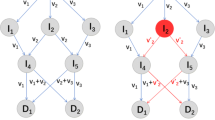Abstract
Network coding can improve the information transmission efficiency and reduces the network resource consumption, so it is a very good platform for information transmission. Certificateless proxy signatures are widely applied in information security fields. However, certificateless proxy signatures based on classical number theory are not suitable for the network coding environment and cannot resist the quantum computing attacks. In view of this, we construct certificateless network coding proxy signatures from lattice (LCL-NCPS). LCL-NCPS is new multi-source signature scheme which has the characteristics of anti-quantum, anti-pollution and anti-forgery. In LCL-NCPS, each source node user can output a message vector to intermediate node and sink node, and the message vectors from different source nodes will be linearly combined to achieve the aim of improving the network transmission rate and network robustness. In terms of efficiency analysis of space dimension, LCL-NCPS can obtain the lower computation complexity by reducing the dimension of proxy key. In terms of efficiency analysis of time dimension, LCL-NCPS has higher computation efficiency in signature and verification.
Similar content being viewed by others
References
Shamir A. Identity-based cryptosystem and signature schemes. In: Proceedings of the CRYPTO 1984. 1984, 47–53
Al-Riyami S S, Paterson K G. Certificateless public key cryptography. In: Proceedings of the 9th International Conference on the Theory and Application of Cryptology and Information Security. 2003, 452–473
Yu H, Wang S. Certificateless threshold signcryption scheme with secret sharing mechanism. Knowledge-Based System, 2021, 221: 106981
Mambo M, Usuda K, Okamoto E. Proxy signatures for delegating signing operation. In: Proceedings of the 3rd ACM Conference on Computer and Communications Security. 1996, 48–57
Deng L Z, Hu Z Y, Ruan Y, Wang T. Provably secure certificateless proxy scheme in the standard model. Journal of Internet Technology, 2022, 23(2): 279–288
Tang Y, Wang F, Ye Q, Yan X. Provably secure efficient certificateless proxy signature scheme. Journal of Frontiers of Computer Science and Technology, 2016, 10(9): 1282–1289
Zhang Y, Li J, Yuan H. Certificateless proxy signature scheme. Journal of Nanjing University of Information Science and Technology: Natural Science Edition, 2017, 9(5): 490–496
Shor P W. Algorithms for quantum computation: discrete logarithms and factoring. In: Proceedings of the 35th Annual Symposium on Foundations of Computer Science. 1994, 124–134
Xia F, Yang B, Ma S, Sun W, Zhang M. Lattice-based proxy signature scheme. Journal of Hunan University: Natural Sciences, 2011, 38(6): 84–88
Li M X, Zheng Y Y, Xu M. Lattice-based proxy signature scheme in the standard model. Journal of Sichuan University: Engineering Science Edition, 2014, 46(1): 102–106
Jiang M M, Hu Y P, Wang B C, Wang F H, Lai Q Q. Efficient proxy signature over lattices. Journal of Beijing University of Posts and Telecommunications, 2014, 37(3): 89–92
Lu X, Wen Q, Wang L. Efficient lattice-based proxy signature supporting revocation. Journal of Sichuan University: Engineering Science Edition, 2016, 48(1): 139–145
Fan Z, Ou H W, Pei T. A certificateless proxy re-signature scheme based on lattice. Journal of Cryptologic Research, 2020, 7(1): 15–25
Chen J S, Hu Y P, Liang H M, Gao W. Novel efficient identity-based signature on lattices. Frontiers of Information Technology & Electronic Engineering, 2021, 22(2): 244–250
Zhu H, Wang Y, Wang C, Cheng X. An efficient identity-based proxy signcryption using lattice. Future Generation Computer Systems, 2021, 117: 321–327
Luo H, Wang C F, Fen F, Yu Z X. On homomorphic signature scheme for multi-source network coding. Application Research of Computers, 2011, 28(4): 1465–1469
Yu H, Gao X. Homomorphic ring signature scheme technology for multi-source network coding. Netinfo Security, 2019, 19(2): 36–42
Yu H, Li W. Homomorphic signature schemes for single-source and multi-source network coding. Journal on Communications, 2019, 40(11): 112–121
Yu H, Bai L, Hao M, Wang N. Certificateless signcryption scheme from lattice. IEEE Systems Journal, 2021, 15(2): 2687–2695
Gentry C, Peikert C, Vaikuntanathan V. Trapdoors for hard lattices and new cryptographic constructions. In: Proceedings of the 40th Annual ACM Symposium on Theory of Computing. 2008, 197–206
Lyubashevsky V. Lattice signatures without trapdoors. In: Proceedings of the 31st Annual International Conference on the Theory and Applications of Cryptographic Techniques. 2012, 738–755
Yu H, Qi Z, Liu D, Yang K. Certificateless multisignature scheme suitable for network coding. Security and Communication Networks, 2021, 2021: 1609873
Yang M, Luo J, Li L. Signatures for multi-source network coding. China Communications, 2010, 7(1): 131–137
Niu S F, Wang C F. Homomorphic signature algorithm for multi-source linear network coding. Computer Engineering, 2012, 38(2): 126–128
Pointcheval D, Stern J. Security arguments for digital signatures and blind signatures. Journal of Cryptology, 2000, 13(3): 361–396
Li T, Chen W, Tang Y, Yan H. A homomorphic network coding signature scheme for multiple sources and its application in IoT. Security and Communication Networks, 2018, 2018: 9641273
Yu H, Li W. A certificateless signature for multi-source network coding. Journal of Information Security and Applications, 2020, 55: 102655
Yu H, Wang W. Certificateless network coding ring signature scheme. Security and Communication Networks, 2021, 2021: 8029644
Acknowledgements
This work was supported by the Key Project of Natural Science Basis Research Plan of Shaanxi Province (2020JZ-54).
Author information
Authors and Affiliations
Corresponding author
Additional information
Huifang Yu received PhD degreee in cryptography from Shaanxi Normal University, China. She is a professor of Xi’an University of Posts & Telecommunications, China. Her research interests include cryptographic theory, data security, anti-quantum cryptography and network coding schemes. She has completed more than twenty research projects including 973 Basic Research Project of China and National Natural Science Foundation of China. She has published three books, sixteen national invention patent and more than eighty papers.
Ning Wang received master degree in cyberspace security in 2022 from Xi’an University of Posts & Telecommunications, China. His main research interests include lattice-based public key cryptography and secure network coding.
Electronic supplementary material
Rights and permissions
About this article
Cite this article
Yu, H., Wang, N. Certificateless network coding proxy signatures from lattice. Front. Comput. Sci. 17, 175810 (2023). https://doi.org/10.1007/s11704-022-2128-z
Received:
Accepted:
Published:
DOI: https://doi.org/10.1007/s11704-022-2128-z





